Joyfire Publishing
Website

Info
If you see too much of this symbol  then you need to customise your settings. If you are using the Google Chrome browser, click the top right symbol then you need to customise your settings. If you are using the Google Chrome browser, click the top right symbol  to 'Customise and control Google Chrome'. Next place the cursor on 'More Tools', then 'Encoding' and then click Western (Windows-1252). to 'Customise and control Google Chrome'. Next place the cursor on 'More Tools', then 'Encoding' and then click Western (Windows-1252).
Click here to download
Acrobat Reader!

|
|
|
Space Weather & Energy Driven Evolutionary Change
The Celestial Deluge &
Arrival of Cosmic Fire
|
|
The Electromagnetic Universe
“From the smallest particle to the largest galactic formation, a web of electrical circuitry connects and unifies all of nature, organizing galaxies, energizing stars, giving birth to planets and, on our own world, controlling weather and animating biological organisms. There are no isolated islands in an electric universe”.
David Talbott & Wallace Thornhill,
'Thunderbolts of the Gods'
There is great confusion in the astronomical world with major theories being contradicted as powerful new telescopes and space probes reveal many new enigmatic features that defy convention explanation. Incredibly, when astronomers wish upon a star, they wish they knew more about how and why stars explode! Yet, for over one hundred years, a few scientists have believed that the most powerful force in the Universe is electromagnetic and the more we understand about the properties of plasma, the fundamental state of matter that consists of charged particles that pervades the whole Universe, the more it looks like electricity powers the heavens. The following is a short introduction to the Electromagnetic Universe. Enjoy!
Electricity Powers The Heavens
|
The following is an excerpt from Tuning The Diamonds: Electromagnetism & Spiritual Evolution concerning the increasing awareness of the electromagnetic nature of the cosmos.
This is not well known, but there is a quiet revolution, taking place in astronomy. Progress is such that traditional astronomers privately worry their scientific field will be taken over, by electrical engineers! [20] This has been going on for a few decades now, but with the latest technology in the form of artificial satellites, space probes and powerful telescopes, traditionalists are getting a shock, literally! The evidence points to the universe being electrically alive and what is being observed can only be explained in terms of matter, in the highly energetic state of plasma. Some scientists have coined the phrase, The Plasma Universe, to reflect the discovery that in volume, 99.999% of all the observable matter in the universe exists in the plasma state.
Known as the “Fourth State of Matter”, a plasma is a substance in which many of the atoms or molecules are effectively ionized, allowing charges to flow freely. Since 99.999% of the known universe is in the plasma state, plasmas should really be considered the First State of Matter, the basic primordial substance of the Universe. Some believe that the Universe made up of plasma may be eternal and infinite.
Studies reveal that plasmas have unique physics compared to solids, liquids, and gases, but unfortunately they are routinely treated as extremely hot gases and this is often incorrect. Examples of plasmas include the sun, much of interplanetary, interstellar, and intergalactic space, the Earth's ionosphere and parts of the atmosphere around lightning discharges. Like all cosmic objects in our solar system, the Earth's moon has it's own plasmasphere within the Sun's plasmasphere like an egg surrounded by it's own yolk. This region extends out to 10,000 kilometers (6,214 miles). The point of separation is called a double layer that forms to differentiate electrical environments. Within double layers, there are strong electric fields that can accelerate particles. Closer to home there are man-made fluorescent light bulbs and other gas-discharge tubes, very hot flames, laser-produced plasmas and plasmas produced for magnetic confinement fusion.
|
|

Plasmas are common in nature and can be found nearly everywhere. Our Sun like all stars is predominately plasma as are most space and astrophysical objects. However, plasmas exist on Earth and the most frequently seen example is lightning.
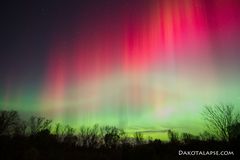
The auroras also known as the Northern and Southern Lights are examples of plasmas. For more information see What is Plasma?
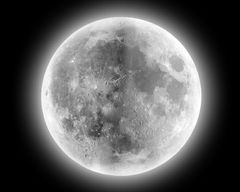
Electric Moon
Click image above to find out more.
|
Electric Enigmas
|
In scientific literature, many new astronomical discoveries are often described as “enigmatic”, “puzzling”, “unbelievable”, “stunning”, “surprising“ or even “mind-boggling”, here are a few examples.
Astrophysicists now admit that space is like a bowl of invisible spaghetti and the spaghetti is vast stretches of filamentary plasma (Birkeland currents) that are usually in “dark mode” so they are hard to detect. However, every now and again, the spaghetti is “squeezed” enough by a strong magnetic field and the star and its surroundings are lit up and become observable by astronomers. Planetary nebulae like IC 4406 provides us with a stunning visible section of this cosmic spaghetti. NASA's Astronomy Picture of the Day (APOD), from July 2008 describes “Hot gas flows out the ends of the cylinder, while filaments of dark dust and molecular gas lace the bounding walls”, but strictly, the correct terminology is plasma and not gas, but besides that, this explanation could not be clearer. In terms of standard plasma cosmology, we are seeing double layers and the typical cellular structure of plasma.
The enigmatic Red Square nebula is one of the most beautiful objects in the universe. (A nebula is an interstellar cloud of gas, dust and plasma where stars can both emerge and die.) Seen in the infrared, the nebula resembles a giant, glowing red box in the sky, with a bright white inner core. Astronomers believe that it represents a dying star called MWC 922, located at the system’s center, which is ejecting matter from opposite poles into space.
The Red Square ranks among the most symmetrical objects ever observed by scientists. “If you fold things across the principle diagonal axis, you get an almost perfect reflection symmetry,” said study leader Peter Tuthill from the University of Sydney in Australia. “This makes the Red Square nebula the most symmetrical object of comparable complexity ever imaged.” Interestingly, The Red Square Nebula probably shows basic octahedron geometry. Source for more information:Near-Perfect Symmetry Revealed in Red Cosmic Square
|
|
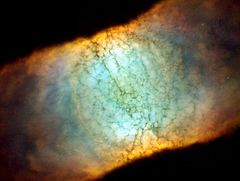
Planetary nebulae like IC 4406
Credit: NASA/Hubble Heritage/C. R. O'Dell.
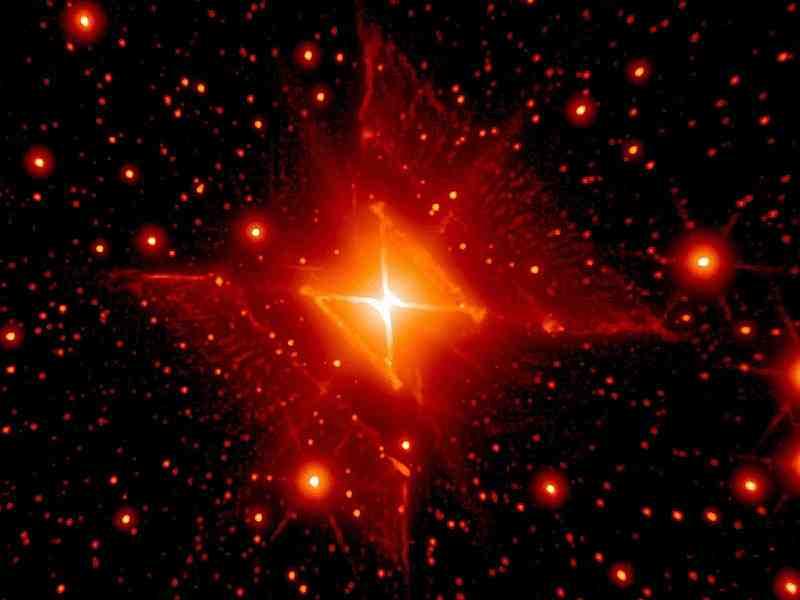
MWC 922: The Red Square Nebula.
This image combines data from the Mt Palomar Hale telescope and the Keck-2 telescope. It was taken in near-infrared light (1.6 microns) and shows a region 30.8 arcseconds on a side around MWC 922. As the outer periphery of the nebula is very faint compared to the core, the image has been processed and sharpened to display the detail and structure. Credit: Peter Tuthill (Sydney U.) and James Lloyd (Cornell).
|
Electric Currents in Space Explained.
|
An electric current in space plasma is generally known as a Birkeland current, after the Norwegian scientist Kristian Birkeland who in 1903, first suggested their existence. Birkeland is the founder of experimental astrophysics and the grandfather of plasma physics who is famed for his experiments and expeditions into the Arctic Circle to study the aurora. More specifically, a Birkeland current exists when charged particles in the current follow magnetic field lines. Thus, they are sometimes referred to as field-aligned currents. Birkeland currents often show filamentary, or twisted “rope-like” magnetic structure and this filamentary structure results from the self-constricting magnetic field lines and current paths that may develop in a plasma. Sometimes those twisted shapes are visible and sometimes not - it depends on the strength of the current density being carried by the plasma. Birkeland currents act as powerlines in space.
In our solar system, evidence of these currents were found in 1979, when the Voyager spacecraft detected an enormous Birkeland current connecting Jupiter and its moon Io. Io acts as an electrical generator as it moves through Jupiter's magnetic field, developing 400,000 volts across its diameter and generating an electric current of 3 million amperes that flows along the magnetic field to the planet's ionosphere.
This large-scale structure in the universe, known as the cosmic web reveal galaxies lie along filaments of matter like pearls on a string, and galaxy clusters arise where filaments meet. An international group of astrophysicists used a computer simulation to recreate how the universe grew and and evolved. The simulation image adjacent is a snapshot of the present universe that features a large cluster of galaxies (bright yellow) surrounded by thousands of stars, galaxies and dark matter (web).
|
|
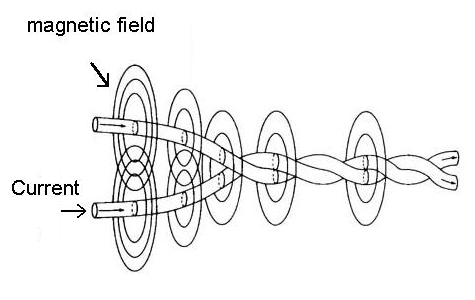
Birkeland Current
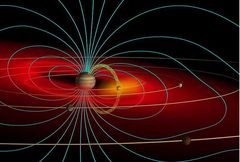
Schematic of the Jovian magnetosphere. It shows the Io Plasma Torus (in red), the Neutral Sodium immediately surrounding Io (in yellow), the Io flux tube (in green), and magnetic field lines (in blue). Credit: John Spencer, Wikipedia Commons
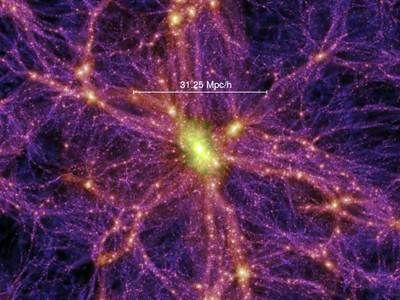
The Cosmic Web
Credit: Virgo Consortium for Cosmological Supercomputer
|
Electric Currents In Space Generate Electric Galaxies!
|
Computer simulations can trace the development of spiral galaxies over time as two globs of plasma interact and form a pair of filaments that eventually produce the entire range of galaxy types. Since 99.999% of the visible universe is in the form of plasma, these charged particles respond to the laws of electromagnetism and because of their small size, more specifically their charge to mass ratio, their low density in space means that gravity and Newton’s laws have very little influence on describing their behaviour.
The adjacent images from a supercomputer simulation trace the development of spiral structure in two interacting plasma blobs over a span of nearly 1 billion years. At the start of the interaction at upper left the filaments are 260,000 light-years apart; all 10 panels are reproduced at the same scale. Simulations such as this can reproduce the full range of observed spiral galaxy types using electromagnetic processes rather than gravitational ones. — Credit: A. Peratt, Plasma Cosmology, 1992. The sequence is animated here.
Right: Image of plasma filaments making up the arms of spiral galaxy M81 with Peratt’s experimental galaxy formation sequence from plasma beneath for comparison.
Incredibly, when plasma physics reveals the interaction of energy pairs, the familiar Ying Yang symbol from Chinese philosophy, appears. This symbology is used to describe how seemingly disjunct or opposing forces are interconnected and interdependent in the natural world, giving rise to each other in turn. —
|
|
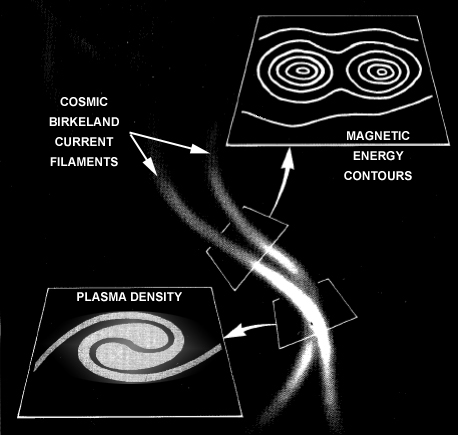
(Right click for larger image)
Credit: A. Peratt, Plasma Cosmology, 1992.
Source
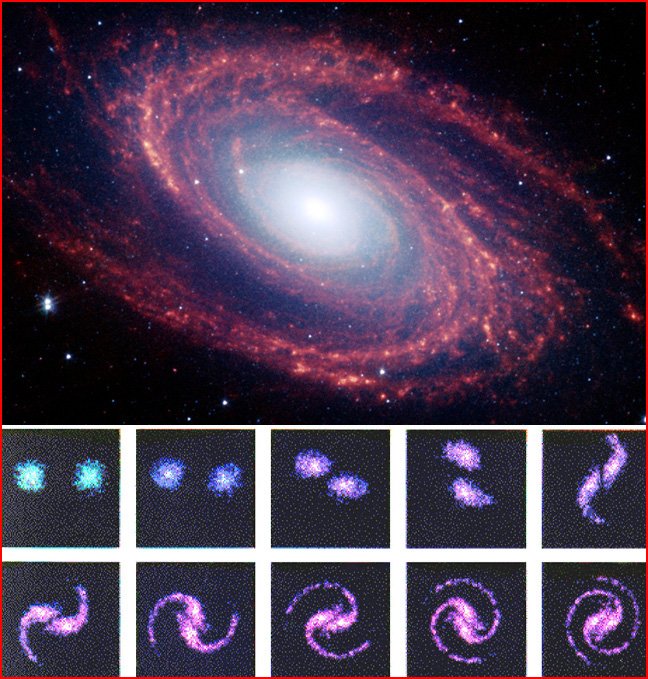 Grand Design Spiral Galaxy M81
Grand Design Spiral Galaxy M81
Object Name: NGC 3031 Object Name: Bode's Galaxy
|
An Electric Galaxy
|
In 1950, Art Hoag discovered the galaxy that bears his name. Hoag's Object is an unusual galaxy that demonstrates a nearly perfect ring of hot, blue stars pinwheeling around its central yellow nucleus. The image on the right is from NASA's Hubble Space Telescope and captures a face-on view. The galaxy's ring of “young” blue stars is most notable as is the dense core and the hovering swarm of globular clusters that lie in the center of the formation. The entire galaxy is about 120,000 light-years wide, which is slightly larger than our Milky Way galaxy.
Astronomers believe that ring-shaped galaxies can form in several different ways and one possible scenario is through a collision with another galaxy. Even though this is pure speculation, the thinking is that sometimes as the second galaxy speeds through the first, it will leaving a 'splash' of star formation. Here, in Hoag's Object, there is no sign of the second galaxy, which leads some to suspect that the blue ring of stars may be the shredded remains of a galaxy that passed nearby and so the reasoning is that any encounter must have occurred about 2 to 3 billion years ago.
Of course there is an alternative explanation that can be demonstrated in the laboratory and with computer simulations and does not require guesswork. The Electric Universe and the plasma cosmology model of galaxy formation only requires a magnetic pinch at the intersection of cosmic Birkeland current filaments. Hoag’s object simply
shows the detailed features of the ‘penumbra’ of a plasma focus discharge.
Right: Penumbra of a dense plasma focus from a discharge current of 174,000 amperes. The rotational structure of the penumbra has a periodicity of 56 as shown by the 56-dot overlay pattern. For more information see, Is Hoag’s Object a Dense Plasma Focus?
|
|
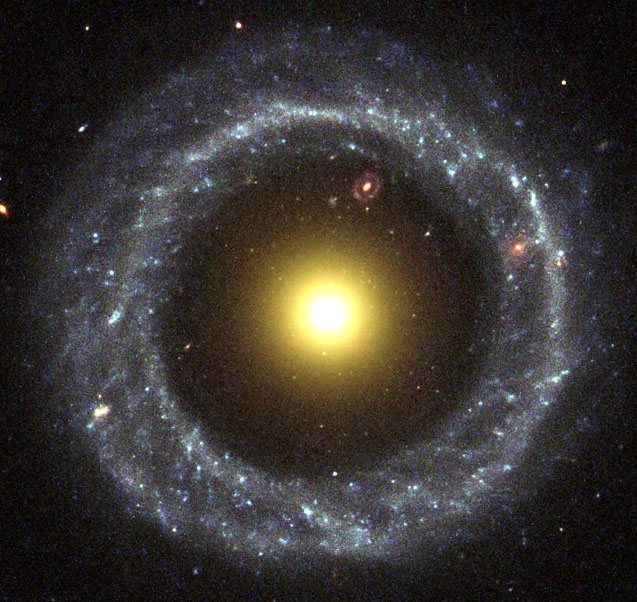 Hoag's Object Hoag's Object Credit: NASA and The Hubble Heritage Team (STScI/AURA) Acknowledgment: Ray A. Lucas (STScI/AURA)
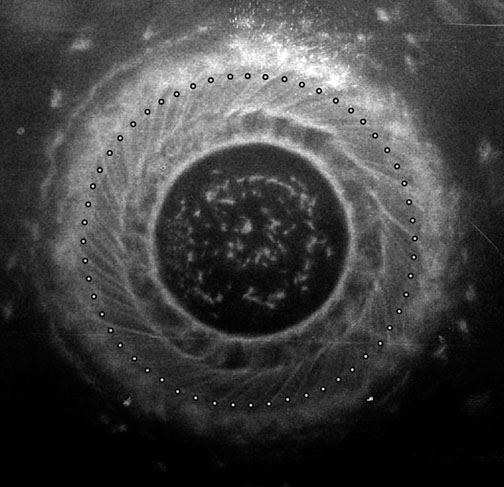 Penumbra of a dense plasma focus Credit A. Peratt.
|
The Formation of Stars
|
The Hubble telescope has revealed one of the most unusually long planetary nebulae found so far. The Elongated Planetary Nebula Henize 3-401: seen right reveals two very long cylindrical outflows with intricate thread-like structures and tattered ends. We are seeing the central star responsible for the beautiful display for the first time in this image.
Scientists think planetary nebulae hold the key to understanding how the Universe became enriched with heavier elements so they study them intensively. Yet, it is not well-understood by astronomers how a perfectly round star can turn into such an unusual-looking nebula that looks like a neon light.
The answer is simple, but it requires understanding that electrical discharges in plasma will generate a tube-like sheath along its axis. A sufficiently energetic discharge will cause the sheath to glow, and it may generate several embedded sheaths. The sheath is actually a “double layer”, a thin sheet in which positive charges build up on one side and negative charges build up on the other. Therefore, a strong electrical field exists between the sides and an electrical current flows along these sheaths. As some of the charges accelerate they emit microwave (and often optical and x-ray) radiation, but often this is undetectable unless a probe flies through it.
Because the light is produced by electrical discharge, the relevant model for a nebula is a laboratory “gas-discharge tube”, similar to a neon light, which emits light only at the excitation frequency of the gas. The Astronomers' model of a shock wave from an explosion predicts emitted light at many frequencies due to heating of the gas. But over 90% of the light from planetary nebulas comes in a single frequency: that of doubly ionized oxygen. Hence we can think of the Henize Nebula as a light-year-long oxygen discharge tube.
Every electric current is associated with a surrounding magnetic field. This magnetic field, like all magnetic fields, is quite susceptible to instabilities. When this happens, there is a pinching effect on the plasma filament, as shown right: There are several types of pinches, two of which are shown. In the top figure, where this pinch happens, the material in the pinch is compressed into a ball, and stars form. It's as simple as that. The star at the center of the pinch can be clearly seen in the nebulae images above and below.
However, if the electrical stress on the central star (which acts as an electrode) becomes too great, it will fission into two or more bodies, thereby increasing the surface area of the electrode so that it can accept a greater current load. This likely explains why most if not all central stars in planetary nebulas are double. For a more detailed explanation, see Nebulas The “Shocking” Answers.
|
|
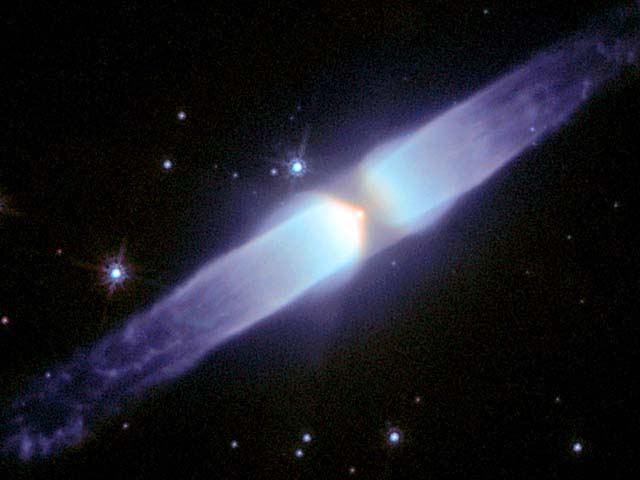 Henize 3-401: An Elongated Planetary Nebula. Henize 3-401: An Elongated Planetary Nebula.
Credit: European Space Agency and Pedro Garcma-Lario (ESA ISO Data Centre)
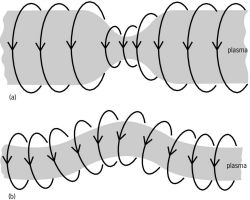 Pinching effects on the plasma filament
Pinching effects on the plasma filament
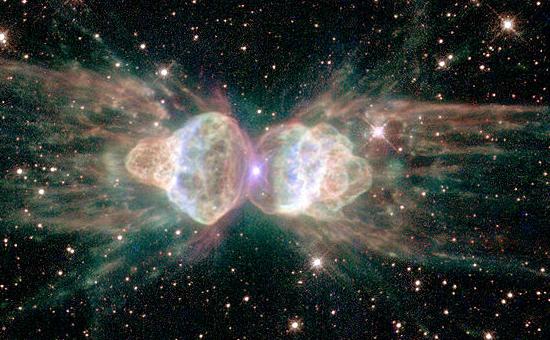
The Ant planetary nebula (Menzel 3 or Mz 3). STScI-PRC2001-05
NASA, ESA & the Hubble Heritage Team (STScI/AURA). Acknowledgment: R. Sahai (Jet Propulsion Lab), B. Balick (University of Washington
|
Astronomers Wishing on a Star
|
Wishing on a star: Cosmologists, astrophysicists and astronomers provide “text book” answers but often they don't really know if they are right!
In an Electric Universe, stars form in “kinks” in a discharge channel. Where the channel bends, matter tends to accumulate. It forms a spinning sphere in which external electromagnetic “pinch” forces are balanced by internal pressure from the increasing density of plasma.
In contrast to the confident approach of the Electric Theory we find conventional astronomers publicly admitting their concerns. “We put the theory in the textbooks because it sounds right. But we don't really know it's right, and I think people are beginning to worry,” says Robert Kirshner, a supernova researcher at the Harvard-Smithsonian Center for Astrophysics (CfA) in Cambridge, Massachusetts. “We keep saying the same thing, but the evidence for it doesn't get better, and that's a bad sign.” Kirshner was among more than 100 experts on stars and their explosions who gathered to discuss their worries last month at the Kavli Institute for Theoretical Physics at the University of California, Santa Barbara. General agreement emerged that the textbook story “is a little bit of 'the emperor has no clothes,'” as Lars Bildsten, an astrophysicist at the Kavli Institute, put it.
“There's a lot of holes in the story.” “I wouldn't say it's a crisis,” [Kirschner] said. “But if you ask, 'Are the pieces falling into place?' I'd say the answer is no.” Understanding type Ia supernovae has become an urgent issue in cosmology, as they provide the most compelling evidence that the universe is expanding at an accelerating rate.” Science 13 April 2007: Vol. 316. no. 5822, pp. 194 - 195 Paper Source information: The Astrophysical Crisis at Red Square
|
|
(Right click for larger image)
HST image of Type Ia supernovae SN 1994D in NGC 4526 Credit: NASA/ESA, The Hubble Key Project Team and The High-Z Supernova Search Team
Supernovae are exploding stars. These stellar explosions are responsible for creating all the elements heavier than iron and for distributing the elements synthesized throughout the star's lifetime to the interstellar medium. Learn more...
If the Electric Universe theory is correct then we have to concede the fact that it's possible that massive electric currents in space can effect us on Earth.
|
The Electric Earth
|
Auroras — sometimes called Northern Lights — are fluctuating light manifestations mostly seen in the sky in the extreme northern and southern latitudes. These scintillating lights can take the form of diffuse patches or dancing streamers, bouncing arcs, shifting rays and, quite often, ephemeral hanging draperies which seem to sway. They can appear in varying shades of red, yellow, green, blue and purple, an ephemeral light show that can be captured to make wonderful photography. Auroras rarely reach below 60 kilometers, and can range up to 1000 kilometers. Frequently, when viewed from space, a complete aurora will appear as a circle around one of the Earth's magnetic poles.
This natural phenomena has always held a great fascination and ancient folklore retained by indigenous groups suggest that the polar lights may been much more powerful in the past. As early as the mid 18th century, eminent scientists realised that the auroras were an electromagnetic phenomena, but it took over two hundred years before this became accepted in the wider scientific community. In 1740, Anders Celsius, the inventor of the centigrade scale named after him, repeatedly noticed that a big compass needle on his desk changed its orientation every time an aurora appeared in the sky above Uppsala, Sweden.
The Norwegian scientist Kristian Birkeland (1867-1917), devoted a great portion of his life to an intensive investigation of the enigmatic aurora borealis. He reasoned that electrons could be ejected by the Sun toward Earth and these electrons could be captured by Earth's magnetic field, that would focus them at the Earth's poles. He made the perfectly reasonable suggestion that these electrons might flow through the upper atmosphere and glow like electrical discharges seen in laboratory plasma experiments. Of course, it took decades until the early 1960s, when Russian and American space probes were blasted with a stream of electric particles flowing from the Sun, for him to be proven right. As Lucy Jago, who wrote a biography of Birkeland called The Northern Lights noted, “rejection of his theories probably slowed the advance of geomagnetic and auroral physics for nearly half a century.” Please note: the Electric Universe is still being largely shunned by the astronomical community but this is changing and cooperation between plasma cosmologists and astronomers is taking place. Amongst the wider community, it is being widely embraced due to successful predictions by Electric Universe proponents and new startingly evidence combined with plasma experimentation combined with computer simulation.
It is clear that the electrical conditions in our solar system have changed and are becoming more extreme. Thus geomagnetic storms and auroras are just one obvious way that our planet interacts with the wider electromagnetic environment of our solar system and even our galaxy. Yet, scientists tell us that earthquakes and hurricanes are also influenced by electric currents that connect the magnetosphere with the ionosphere. Moreover, in recent years, a host of new electrical phenomena in the Earth's upper atmosphere is giving scientists some grave concerns.
Oct 22, 1999: At 9:00 a.m. MDT (1500 UT), NOAA's Space Environment Center reported that a strong geomagnetic storm was in progress. The storm is possibly the result of a shock observed in the solar wind on Oct 21 at 01:38UT (Oct 20 at 07:38 p.m. MDT), originating from a mass ejection on the Sun Oct 18. The shock front struck Earth's magnetosphere around 0240 UT on October 21. “This storm is notable, at least for us Americans, because it's producing aurora over the contiguous 48 states,” said NASA/Marshall's Dr. Jim Spann a co-investigator on Polar's UVI instrument. For more details click the above image.
|
|
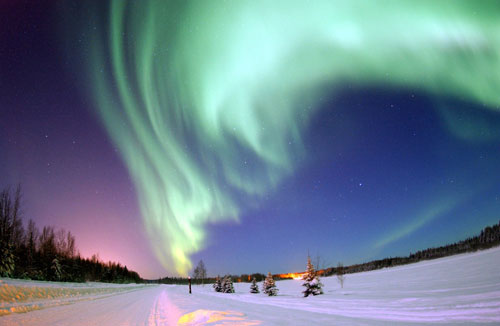
This digitally-enhanced photograph shows an aurora borealis above the frozen landscape of Bear Lake, Alaska For a small selection see the New Scientists gallery Auroras: The greatest light show on Earth or a huge selection at Spaceweather.com aurora gallery. Credit: GSFC / MSFC / NASA.
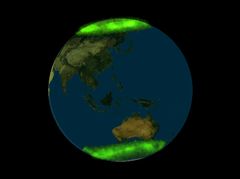 Auroras Over Both Earth Poles Auroras Over Both Earth Poles Credit: Polar VIS, JPL, NASA
Auroras in the north and south can be nearly mirror images of each other. This was confirmed in October 2001 by detailed images from NASA's orbiting Polar spacecraft. Click the image to find a time-lapse movie showing the simultaneous changes in the aurora borealis, at the top, and the aurora australis, at the bottom.
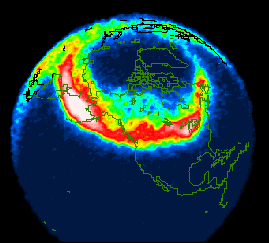 An Auroral Storm An Auroral Storm Credit: Polar VIS, JPL, NASA
Plasma Cosmology Vs Electric Universe Theory
Some plasma physicists, astronomers and astrophysicists are incorporating important concepts that have been known for nearly a century to form the basis of Plasma Cosmology. Electric Universe theory is a variant of Plasma Cosmology and while they share more similarities than differences, it should be noted that Electric Universe ideas tend to go a step further than the generally more conservative approach of Plasma Cosmology.
|
Joyfire Tour Home
  Next
|
|
 Home
Joyfire Science & Metaphysics Integration
Copyright © 2003 – 2025. All rights reserved.
|
|
Missing Images?
Search Engines
Censor Images
From This Website!
Use Yandex.com!

Has the article disappeared? Try the Way Back Machine
Internet Archive
Click image for link
Geomagnetic storm header Credit: Jüri Voit
|
|

